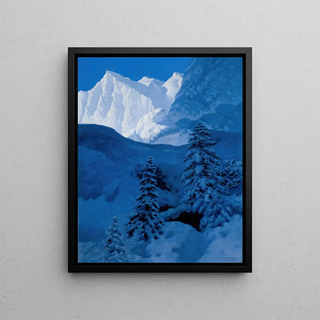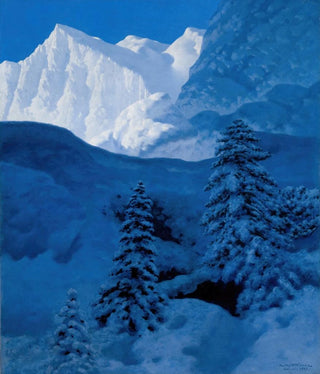Art print | Winter Nest - Stanisław Witkiewicz


View from behind

Frame (optional)
Winter Nest - Stanisław Witkiewicz – Captivating Introduction
In the vast panorama of art history, certain works transcend time and space, captivating the imagination of viewers across ages. "Winter Nest" by Stanisław Witkiewicz is one of those creations that evoke an atmosphere both mysterious and warm. This piece, which highlights the fragile beauty of nature in winter, invites us to immerse ourselves in a universe where melancholy and wonder coexist. Through this canvas, Witkiewicz manages to capture the very essence of the cold season, transforming a snowy landscape into a poetic and contemplative scene. The work is a true homage to nature, to its ephemeral beauty, and to its capacity to inspire the human soul.
Style and uniqueness of the work
Witkiewicz's style is distinguished by an approach that is both realistic and romantic, where each brushstroke seems to tell a story. In "Winter Nest," shades of blue and white blend harmoniously, creating an atmosphere of calm and serenity. The meticulous details of snow-laden branches and the softness of shadows evoke an almost tangible reality, while leaving room for a dreamlike dimension. The artist uses light with remarkable mastery, subtly illuminating certain areas of the canvas, which enhances the sense of depth and perspective. This piece, far from being a simple winter landscape, becomes a reflection on solitude and the beauty of nature, inviting the viewer to introspective contemplation.
The artist and his influence
Stanisław Witkiewicz, an emblematic figure of the Polish artistic movement of the early 20th century, knew how to mark his era with a unique vision of art. Influenced by symbolism and impressionism, he developed a personal style that combines sensitivity with technique. Witkiewicz does not merely depict the world around him; he seeks to express deep emotions and states of mind through his works. His innovative approach paved the way for many contemporary artists, who see in him a source of inspiration. Through "Winter Nest," he offers us a window

Matte finish

View from behind

Frame (optional)
Winter Nest - Stanisław Witkiewicz – Captivating Introduction
In the vast panorama of art history, certain works transcend time and space, captivating the imagination of viewers across ages. "Winter Nest" by Stanisław Witkiewicz is one of those creations that evoke an atmosphere both mysterious and warm. This piece, which highlights the fragile beauty of nature in winter, invites us to immerse ourselves in a universe where melancholy and wonder coexist. Through this canvas, Witkiewicz manages to capture the very essence of the cold season, transforming a snowy landscape into a poetic and contemplative scene. The work is a true homage to nature, to its ephemeral beauty, and to its capacity to inspire the human soul.
Style and uniqueness of the work
Witkiewicz's style is distinguished by an approach that is both realistic and romantic, where each brushstroke seems to tell a story. In "Winter Nest," shades of blue and white blend harmoniously, creating an atmosphere of calm and serenity. The meticulous details of snow-laden branches and the softness of shadows evoke an almost tangible reality, while leaving room for a dreamlike dimension. The artist uses light with remarkable mastery, subtly illuminating certain areas of the canvas, which enhances the sense of depth and perspective. This piece, far from being a simple winter landscape, becomes a reflection on solitude and the beauty of nature, inviting the viewer to introspective contemplation.
The artist and his influence
Stanisław Witkiewicz, an emblematic figure of the Polish artistic movement of the early 20th century, knew how to mark his era with a unique vision of art. Influenced by symbolism and impressionism, he developed a personal style that combines sensitivity with technique. Witkiewicz does not merely depict the world around him; he seeks to express deep emotions and states of mind through his works. His innovative approach paved the way for many contemporary artists, who see in him a source of inspiration. Through "Winter Nest," he offers us a window






